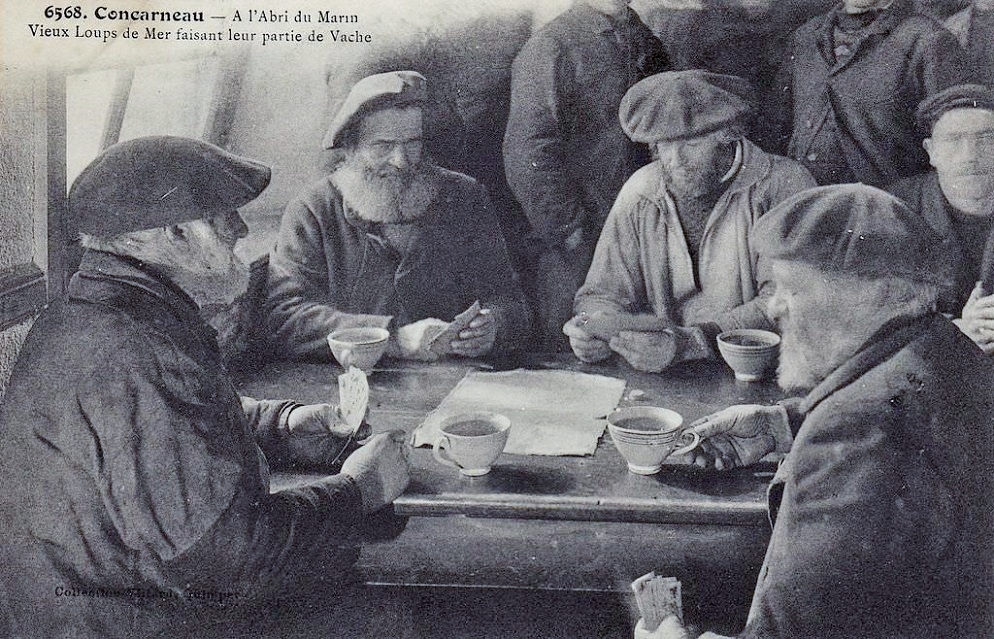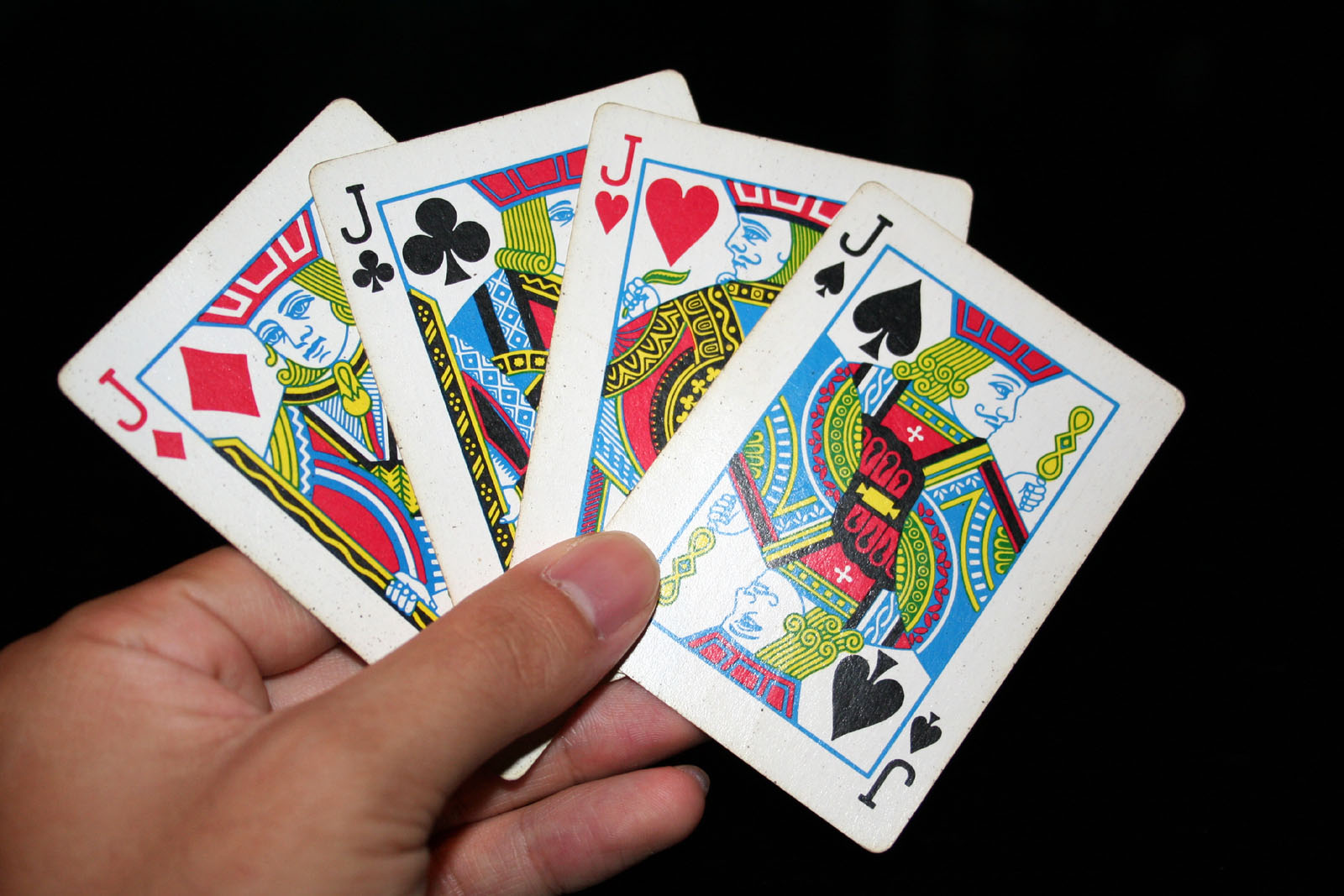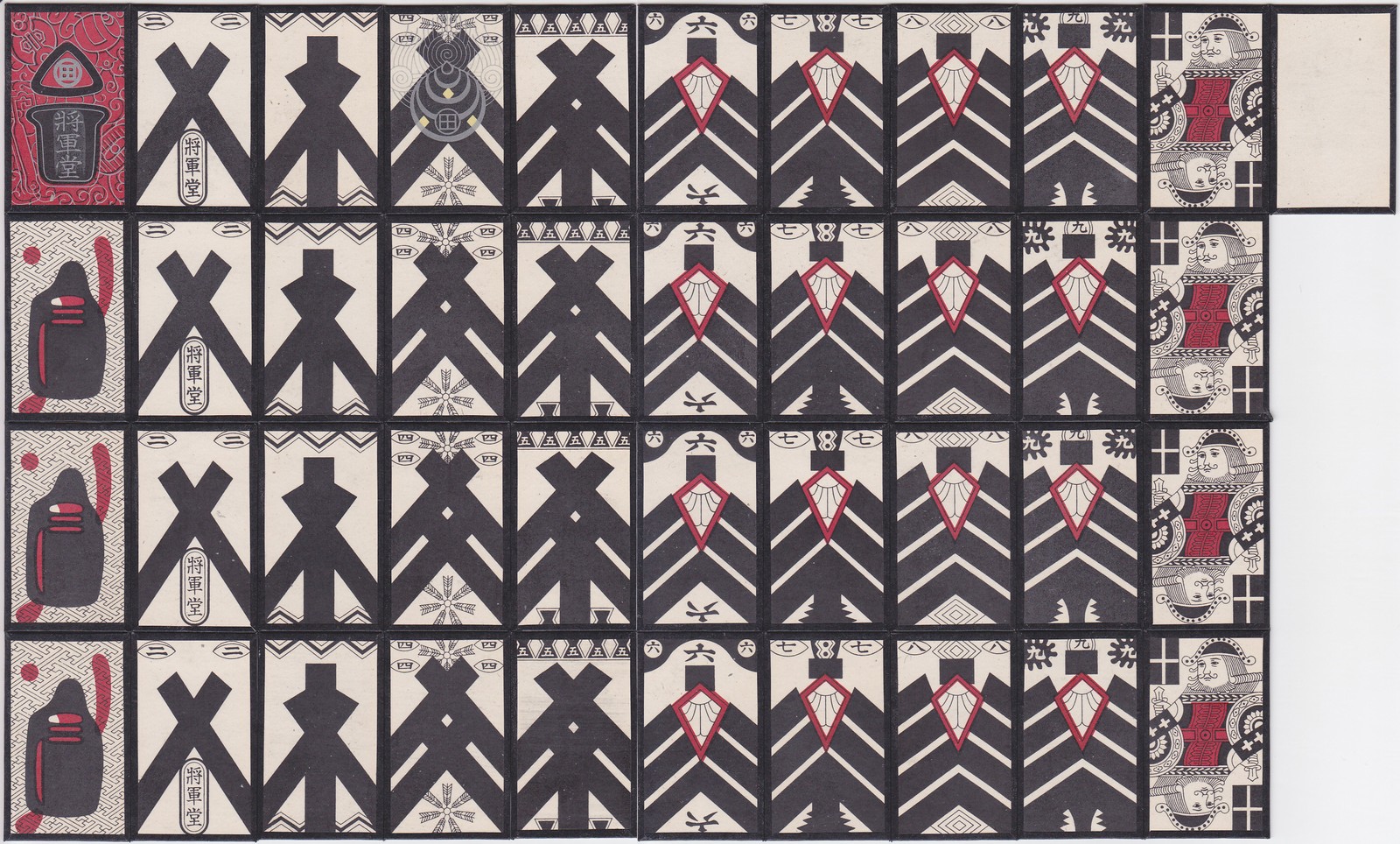|
Suit Of Batons
Batons or clubs is one of the four suits of playing cards in the standard Latin deck along with the suits of cups, coins and swords. 'Batons' is the name usually given to the suit in Italian-suited cards where the symbols look like batons. 'Clubs' refers to the suit in Spanish-suited cards where the symbols look more like wooden clubs. Before 1800, French cardmakers, who also made Spanish card games, called them ''cartes à bâtons''. Symbol on Italian pattern cards: Symbol on Spanish pattern cards: Symbol on French Aluette (Spanish-)pattern cards: Characteristics The suit of batons is believed to have derived from Chinese money-suited cards' String of cash coins suit being misinterpreted as polo-sticks by the Muslims when the cards came into contact with the Islamic world. This misinterpretation as sticks is also the case for Mahjong's suit of Bamboo sticks. Since polo was an obscure sport in Europe, the sticks further developed into cudgels in Sp ... [...More Info...] [...Related Items...] OR: [Wikipedia] [Google] [Baidu] |
Trentine Pattern
Playing cards (in Italian: ''carte da gioco'') have been in Italy since the late 14th century. Until the mid 19th century, Italy was composed of many smaller independent states which led to the development of various regional patterns of playing cards; "Italian suited cards" normally only refer to cards originating from northeastern Italy around the former Republic of Venice, which are largely confined to northern Italy, parts of Switzerland, Dalmatia and Bay of Kotor, southern Montenegro. Other parts of Italy traditionally use traditional local variants of Spanish playing cards, Spanish suits, French playing cards, French suits or German playing cards, German suits. As Latin-suited cards, Italian and Spanish suited cards use swords (''spade''), cups (''coppe''), coins (''denari''), and clubs (''bastoni''). All Italian suited decks have three face cards per suit: the ''fante'' (Jack (playing card), Knave), ''cavallo'' (Knight (playing card), Knight), and ''re'' (King (playing ca ... [...More Info...] [...Related Items...] OR: [Wikipedia] [Google] [Baidu] |
Aluette
Aluette or Vache ("Cow") is an old, plain trick-taking card game that is played on the west coast of France. It is played by two teams, usually of four people, but sometimes also of six. It is unusual in using a unique pack of 48 Spanish playing cards and a system of signalling between playing partners. The French colloquial names for the game, ''jeu de la Vache'' or ''Vache'', refer to the cow depicted on one of the cards. History The game is very old, with references to the game of "luettes" by François Rabelais in the early 16th century. As the cards use Spanish playing cards, Spanish suits, Aluette may even predate the invention of French playing cards around 1480. "''La luette''" means uvula in French and may refer to the fact that it is played with codified signs that allow team members to provide information on their cards during the game. The game is also called "''la vache''" (the cow) because of the illustration on the 2 of cups card. Due to similarities it has with th ... [...More Info...] [...Related Items...] OR: [Wikipedia] [Google] [Baidu] |
Knight (playing Card)
A knight or cavalier is a playing card with a picture of a man riding a horse on it. It is a standard face or court card in Italian and Spanish packs where it is usually referred to as the 'knight' in English, the ''caballo'' in Spanish or the ''cavallo'' in Italian. It ranks between the knave and the king within its suit; therefore, it replaces the queen, nonexistent in these packs. The card also features in tarot and tarock packs. In French-suited tarot packs it is usually called the 'cavalier' in English, the ''chevalier'' in French or the ''Cavall'' or ''Reiter'' in German. and ranks between the jack and the queen. Knights do not appear in German or Swiss playing cards; their place being occupied by an upper knave card called the Ober. One exception is the Württemberg pattern where the Obers are seen riding on horses. This depiction was inspired by Cego tarot decks during the 19th century. History In the original Mamluk Egyptian deck, there were three court card ... [...More Info...] [...Related Items...] OR: [Wikipedia] [Google] [Baidu] |
Jack (playing Card)
A Jack or Knave, in some games referred to as a Bower, in Tarot card games as a Valet, is a playing card which, in traditional French and English decks, pictures a man in the traditional or historic aristocratic or courtier dress generally associated with Europe of the 16th or 17th century. The usual rank of a jack is between the ten and the queen. The Jack corresponds to the Unter in German and Swiss-suited playing cards. History The earliest predecessor of the knave was the (second or under-deputy) in the Mamluk card deck. This was the lowest of the three court cards, and, like all court cards, was depicted via abstract art or calligraphy. When brought over to Italy and Spain, the was made into the fante (an infantry soldier) and the sota (a page, which ranks below the knight card) respectively. In France, where the card was called the valet, the queen was inserted between the king and the knight. The knight was subsequently dropped out of non-Tarot decks, leaving the ... [...More Info...] [...Related Items...] OR: [Wikipedia] [Google] [Baidu] |
Karuta
are Culture of Japan, Japanese playing cards. Playing cards were introduced to Japan by Portuguese traders during the mid-16th century. These early decks were used for trick-taking games. The earliest indigenous ''karuta'' was invented in the town of Miike District, Miike in Chikugo Province at around the end of the 16th century. The Miike karuta Memorial Hall located in Ōmuta, Fukuoka, is the only municipal museum in Japan dedicated specifically to the history of ''karuta''. ''Karuta'' packs are classified into two groups, those that are descended from Portuguese-suited playing cards and those from ''e-awase''. ''E-awase'' originally derived from ''kai-awase'', which was played with shells but were converted to card format during the early 17th century. The basic idea of any ''e-awase karuta'' game is to be able to quickly determine which card out of an array of cards is required and then to grab the card before it is grabbed by an opponent. It is often played by children at ... [...More Info...] [...Related Items...] OR: [Wikipedia] [Google] [Baidu] |
Suit Of Wands
The suit of wands is one of four suits in tarot, collectively known as the Minor Arcana. Like the other tarot suits, the suit of wands contains fourteen cards: ace (one), two through ten, page and knight (sometimes referred to as princess and prince), queen and king. When Tarot cards are to play Tarocchi, Tarot card games, where wands corresponds to the suit of batons. Tarot cards came to be utilized for Tarot reading, divinatory purposes by esotericists such as Eliphas Levi and were regularized into the divinatory form most known today by the Hermetic Order of the Golden Dawn and the Rider–Waite Tarot, created by a Golden Dawn member.Paul Huson, Huson, Paul, (2004) ''Mystical Origins of the Tarot: From Ancient Roots to Modern Usage'', Vermont: Destiny Books,''Mystical Origins of the Tarot'' Divinatory and occult meanings In Aleister Crowley's 1944 ''The Book of Thoth (Crowley), The Book of Thoth'', the suit of wands is associated with the action of the Will (philosophy), Will ... [...More Info...] [...Related Items...] OR: [Wikipedia] [Google] [Baidu] |
Cartomancy
Cartomancy is fortune-telling or divination using a deck of cards. Forms of cartomancy appeared soon after playing cards were introduced into Europe in the 14th century.Paul Huson, Huson, Paul (2004). ''Mystical Origins of the Tarot: From Ancient Roots to Modern Usage''. Vermont: Destiny Books. Practitioners of cartomancy are generally known as ''cartomancers'', ''card readers'', or simply ''readers''. Cartomancy using standard playing cards was the most popular form of providing fortune-telling card readings in the 18th, 19th, and 20th centuries. The standard 52-card deck is often augmented with joker (playing card), jokers or even with the blank card found in many packaged decks. In France, the 32-card piquet stripped deck is most typically used in cartomantic readings, although the 52 card deck can also be used. (A piquet deck can be a 52-card deck with all of the 2s through the 6s removed. This leaves all of the 7s through the 10s, the face cards, and the aces.) In Englis ... [...More Info...] [...Related Items...] OR: [Wikipedia] [Google] [Baidu] |
Italian Language
Italian (, , or , ) is a Romance language of the Indo-European language family. It evolved from the colloquial Latin of the Roman Empire. Italian is the least divergent language from Latin, together with Sardinian language, Sardinian. It is spoken by about 68 million people, including 64 million native speakers as of 2024. Italian is an official language in Languages of Italy, Italy, Languages of San Marino, San Marino, Languages of Switzerland, Switzerland (Ticino and the Grisons), and Languages of Vatican City, Vatican City; it has official Minority language, minority status in Minority languages of Croatia, Croatia, Slovene Istria, Romania, Bosnia and Herzegovina, and the municipalities of Santa Teresa, Espírito Santo, Santa Tereza, Encantado, Rio Grande do Sul, Encantado, and Venda Nova do Imigrante in Languages of Brazil#Language co-officialization, Brazil. Italian is also spoken by large Italian diaspora, immigrant and expatriate communities in the Americas and Austral ... [...More Info...] [...Related Items...] OR: [Wikipedia] [Google] [Baidu] |
Spanish Language
Spanish () or Castilian () is a Romance languages, Romance language of the Indo-European languages, Indo-European language family that evolved from the Vulgar Latin spoken on the Iberian Peninsula of Europe. Today, it is a world language, global language with 483 million native speakers, mainly in the Americas and Spain, and about 558 million speakers total, including second-language speakers. Spanish is the official language of List of countries where Spanish is an official language, 20 countries, as well as one of the Official languages of the United Nations, six official languages of the United Nations. Spanish is the world's list of languages by number of native speakers, second-most spoken native language after Mandarin Chinese; the world's list of languages by total number of speakers, fourth-most spoken language overall after English language, English, Mandarin Chinese, and Hindustani language, Hindustani (Hindi-Urdu); and the world's most widely spoken Romance language ... [...More Info...] [...Related Items...] OR: [Wikipedia] [Google] [Baidu] |
Polo
Polo is a stick and ball game that is played on horseback as a traditional field sport. It is one of the world's oldest known team sports, having been adopted in the Western world from the game of Chovgan (), which originated in ancient Iran, dating back over 2,000 years. Initially played by Persian nobility as a training exercise for cavalry units, polo eventually spread to other parts of the world. The game is played by two opposing teams with the objective of scoring using a long-handled wooden mallet to hit a small hard ball through the opposing team's goal. Each team has four mounted riders, and the game usually lasts one to two hours, divided into periods called ''chukkas'' or ''chukkers.'' Polo has been called "The Sport of Kings" and has become a spectator sport for equestrians and high society, often supported by sponsorship. The progenitor of polo and its variants existed from the 6th century BC to the 1st century AD, as an equestrian game played by the Ira ... [...More Info...] [...Related Items...] OR: [Wikipedia] [Google] [Baidu] |
Mahjong Tiles
Mahjong tiles () are tiles of Chinese origin that are used to play mahjong as well as mahjong solitaire and other games. Although they are most commonly tiles, they may refer to playing cards with similar contents as well. Development The earliest surviving mahjong sets date to the 1870s when the game was largely confined to Zhejiang, Shanghai, and Jiangsu.Stanwick, Michael, 'Mahjong(g) Before Mahjong(g): Part 1'. In: The Playing-Card, Vol. 32, No. 4, 2004, pp. 153–162. They already exhibited various traits found in modern sets. The core of the set is the 108 suited tiles which were inherited from Chinese money-suited playing cards. The Wind honor tiles and the Four Seasons tiles were also found in the earliest sets. The honor tiles known as Arrows (Dragons in English) developed to their current form by 1890 concurrent with a new style of play called ''Zhōngfā'' (中發). Flower tiles, once known as Outer Flowers (), were not universally accepted until the 1920s. In co ... [...More Info...] [...Related Items...] OR: [Wikipedia] [Google] [Baidu] |
Mahjong
Mahjong (English pronunciation: ; also transliterated as mah jongg, mah-jongg, and mahjongg) is a tile-based game that was developed in the 19th century in China and has spread throughout the world since the early 20th century. It is played by four players (with some three-player variations found in parts of China, Japan, South Korea, Vietnam, and Southeast Asia). The game and its regional variants are widely played throughout East and Southeast Asia and have also become popular in Western countries. The game has also been adapted into a widespread online entertainment. Similar to the Western card game rummy, mahjong is a game of skill, strategy, and luck. To distinguish it from mahjong solitaire, it is sometimes referred to as mahjong rummy. The game is played with a set of 144 tiles based on Chinese characters and symbols, although many regional variations may omit some tiles or add unique ones. In most variations, each player begins by receiving 13 tiles. In turn, p ... [...More Info...] [...Related Items...] OR: [Wikipedia] [Google] [Baidu] |










